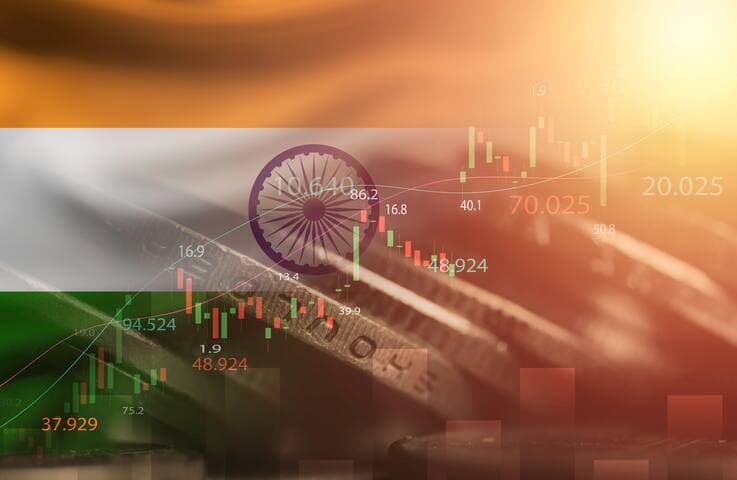Money

Huzaifa Husain
Head of India Equities

What is money? The question is deceptively simple – yet the answers have implications for banks in India and beyond.
Money, unlike energy, can be created and destroyed. The mechanics of money transformation, the role of banks, and its significance in economic growth are worth exploring in some depth.
Money is an IOU (an abbreviation for “I owe you” – an acknowledgement of debt) or a liability of a bank, and accounting rules dictate that for every liability there must be an asset. This corresponding asset for a bank is credit, or debt for borrowers. All money therefore is a mirror image of all debt.
There are primarily two kinds of banks operating within a country: the central bank and commercial banks. IOUs of a central bank generally consist of physical currency, used by individuals and corporations, and electronic deposits, which are typically accessed by commercial banks and the government. IOUs of a commercial bank are generally bank deposits owned by individuals, corporations, and so forth. All individual bank IOUs are interchangeable between banks at par, and this is what is typically called “money”. It is measured in various ways, among which M2 and M3 are widely used.
The above liabilities are generated when corresponding assets come into existence. After all, no bank is going to create an IOU without getting something in return. In earlier times, such IOUs were issued against deposition of gold. Today, typically a bank will extend credit to a company or an individual, and this takes the form of a deposit. In the case of lending to the government, a bank participates in government securities auctions and receives the bonds as assets in lieu of which it deposits ‘money’ in the government’s bank account. In the case of a mortgage loan, the bank extends credit to the borrower, an asset on the books of the bank, while it deposits the money in the account of the seller of the house, a liability on the books of the bank.
Given that all commercial bank IOUs are freely exchangeable with IOUs of the central bank, it follows that all respective IOUs of banks are similarly exchangeable – one rupee of the Reserve Bank of India (RBI), India’s central bank, is the same as one rupee of any other bank in India. This almost magical property of interchangeability is what makes money fluid. The seller of the house – say, a developer – uses its bank deposits to pay its workers, who may have accounts in other banks, and thus money moves. But given that all balance sheets must always be balanced, the first bank that extended the mortgage credit needs to borrow from the bank in which the deposit lies. In some cases, especially when trust between banks breaks down (as happened during the global financial crisis), banks with a surplus in deposits will lend to central banks, and banks with deposit deficits will borrow from the central bank.
When the person who took on credit repays the loan, money is destroyed as the bank’s balance sheet shrinks: Money is created when banks extend credit, and money is destroyed when credit is extinguished. Banks do not use deposits to give credit; instead, deposits arise out of credit and deposits disappear when borrowings are repaid.
This unique property is only available to a bank. A non-bank lender, for example, must borrow from a bank for onward lending, as the IOU of a non-bank lender is not accepted as money, forcing it to use the unique commodity ’money’ created by a bank. In that sense, non-bank lenders or mutual funds or pension funds are not competition to banks but act as intermediaries between banks and eventual users/savers of capital.
If someone uses money, which is the creation of a bank, the bank makes a spread on it, which is typically what it charges on credit less what it pays on deposits. Such income by the central bank is called “seigniorage” but is equally applicable to any commercial bank, as they pay less on deposits and charge more on credit.
When we see debt levels rising for a group such as the government, a corporation, or individuals, it is pertinent to remember that this debt is supporting money in various deposit accounts.
More debt, more money.
Less debt, less money.
No debt, no money.
When India got its independence in 1947, the private sector was not developed, and most of the capital allocation decisions were taken by the government. Therefore, banks used to be large lenders to the government, and to some extent the amount of capital available in the economy was limited to how much debt the government could sustain on its books. Then, in the 1990s, privatization transformed corporates into the biggest capital allocators as banks started lending to them. This was also the time when RBI stopped participating in primary government auctions and it reduced the minimum regulatory threshold that every commercial bank had to invest in government securities. This freed up banks’ ability to lend to companies, though it also caused banks to be mindful of their own capital levels, as commercial lending entailed adherence to capital adequacy norms (unlike lending to the government, which was virtually zero risk).
Starting in the 2000s, banks started targeting individuals to offer credit through credit cards, mortgages, personal loans, etc. As individuals generated a verifiable financial footprint, banks extended credit to them. Today, with digital payments and technological innovations, banks are easily able to lend money at a low cost to individuals.
Economically, there is no difference between who the borrower is for any transaction, whether a government, company, or individual. Say a developer wants to sell a home to an individual. The government can borrow and give it to the individual, say as a grant or a subsidy, and the individual pays the developer. The developer could borrow from the bank, build the house, and eventually sell it to the individual. The individual can borrow and then pay the developer in lieu of the house. The only difference in the above three scenarios is where the debt is reflected – government, company, or individual – which affects the net financial savings of that particular group. Net financial savings, as defined by total bank debt less total bank deposits, of all groups must be zero, given that all assets must be equal to all liabilities.
Can central banks just “print money“?
Now that we have established that all deposits come out of credit, what constrains credit? It is typically said that the central bank can print money at will. Let us explore this assumption.
Central banks can print money by creating assets. In India, RBI typically owns large amounts of foreign assets (credit to foreign entities), and it is assumed that it can buy such assets by ‘printing money’. But who wants to own RBI’s IOUs? Typically, central bank IOUs are not very rewarding economically. Physical currency pays nothing to the owner, and central bank deposits, owned by banks, generally pay below market rates. The only way for RBI to print money is to either force banks to own RBI deposits through regulation or by raising interest rates it pays on those deposits, or by paying higher amounts to buy assets . RBI cannot force citizens to own its zero-coupon perpetual bond: currency.
So, printing money by RBI has its own limitations. This may not hold true for other countries’ central banks, which can extend primary credit to their own governments or buy commercial credit assets like mortgage securities. However, doing so may take a toll on the central bank’s profitability.
Governments can “print money“ by issuing debt, which can be owned by banks. However, doing so raises the government’s interest costs, which affects their budget deficit. In India, given that RBI cannot participate in primary auctions of government securities, the government is forced to raise money from markets at market rates, which limits raising larger and larger sums of money at low rates. Indiscriminate bond issuance by governments is tantamount to printing money, and such issuance will result in inflation; if used judiciously, however, such issuance may avoid this outcome. Sometimes “printing money“ is assumed to be a one-sided transaction, with money landing in a deposit account as if by magic; this is not the reality, as accounting demands a double entry for every transaction.
Commercial banks, meanwhile, are in a better place to “print money“, as they can extend credit to one and all. There are constraints, of course, such as the quality of the borrower or the economic rationale of lending. One of the biggest constraints in India historically has been the low levels of equity among banks. Given that the main regulatory constraint for banks in lending money to anyone other than the government is their own equity capital, or capital adequacy, the total money in an economy is therefore constrained by the amount of equity capital of the banking system. This can easily be verified by looking at the ratio of total bank assets to total bank equity. If one parameter is proportional to another, then the ratio of both should be a constant. This ratio typically fluctuates in a narrow band for every bank based on its risk appetite.
If commercial banks do a good job of extending credit to borrowers who have an ability to use the capital judiciously, then capital allocation in an economy will improve, thereby generating strong economic growth with low inflation. In such a case, more ‘money’ in the system will not stroke inflation but will help a country become prosperous. Inflation typically arises due to poor capital allocation decisions, where more money is not creating productive assets that can supply goods and services the economy needs.
On the flip side, the central bank can control the amount of money “printed” by commercial banks by tweaking the capital adequacy regulations of commercial banks. While other factors affect money creation, the most important constraint in India in the recent past was the equity capital base of banks.
Equity leads to commercial credit, which leads to money formation, which leads to investments – which leads to economic growth and well-being.
In India, banks went through tough times following the financial crisis and were forced to write off large loans, impairing their equity capital. This constrained them from lending, which prevented companies from investing. Post-Covid, banks saw rising profitability, and an accumulation of earnings is enhancing their capital bases. This is helping banks lend money at a fast pace which is clocking 15.9% on a year-on-year basis1. Of course, with digital payments and credit information easily accessible, information arbitrage between borrowers and banks has declined, helping banks price credit well and keep bad loans to a minimum.
In sum, money in India is rising in step with banks’ lending, which helps facilitate economic transactions such as investing in a factory, buying a home, or funding inventory, to name just a few. With equity capital rising, banks in India are well placed to fund even large projects: while banks have limitations on how big a project they can fund, these limits are founded on the size of their equity base. If India were to achieve even 100% M3/GDP from the present 88%, the banks’ balance sheets in turn would need to grow by 14% and then keep pace with nominal GDP growth2. If this comes to pass, historically credit-starved India will see a new era of investment growth.
Appendix: Illustrated Overview of the Global Bank Industry
Total money (M2/M3) of select geographies

Source: Bloomberg, as of 30 May 2024 *M2; others M3
Top 10 listed banks in the world by size of their equity base

Source: Bloomberg, as of 30 May 2024
India M3 composition

Source: RBI, as of 3 May 2024
India Listed Bank Charts
Banks profits (half yearly)

Banks total equity

Commercial credit outstanding

Source: PineBridge Investments, as of May 2024
Disclosure
Investing involves risk, including possible loss of principal. The information presented herein is for illustrative purposes only and should not be considered reflective of any particular security, strategy, or investment product. It represents a general assessment of the markets at a specific time and is not a guarantee of future performance results or market movement. This material does not constitute investment, financial, legal, tax, or other advice; investment research or a product of any research department; an offer to sell, or the solicitation of an offer to purchase any security or interest in a fund; or a recommendation for any investment product or strategy. PineBridge Investments is not soliciting or recommending any action based on information in this document. Any opinions, projections, or forward-looking statements expressed herein are solely those of the author, may differ from the views or opinions expressed by other areas of PineBridge Investments, and are only for general informational purposes as of the date indicated. Views may be based on third-party data that has not been independently verified. PineBridge Investments does not approve of or endorse any republication of this material. You are solely responsible for deciding whether any investment product or strategy is appropriate for you based upon your investment goals, financial situation and tolerance for risk.



